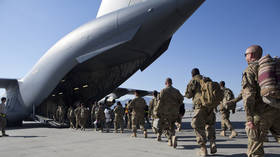US to withdraw from Afghanistan after two decades of war leaving behind a tortured wasteland and having accomplished… NOTHING

The US decision to leave Afghanistan without any conditions represents a political victory for those in the US government who sought an end to the nearly two-decade conflict in that nation.
President Joe Biden, in a departure from a policy embraced by four successive US presidential administrations which placed stringent conditions on determining the conditions under which the US might leave Afghanistan, has announced that he is ordering all US military forces out of Afghanistan by September 11, 2021 – the 20th anniversary of the 9/11 terrorist attacks which propelled the US Afghan intervention to begin with. This decision, which is not linked to any preconditions or other policy contingencies, means the US will finally extricate itself from the two-decade long nightmare in Afghanistan that had become known as “the forever war.”
By rejecting the established model of a “conditions-based approach” when it came to withdrawing US forces from Afghanistan, President Biden liberated himself from the reality that the situation in Afghanistan would never stabilize to the point that the risk-averse generals who populate the US military (and for whom the war in Afghanistan has been an integral part of their respective careers) would feel comfortable leaving. In making this decision, Biden mirrored the conclusion reached by his predecessor, Donald Trump, that left to their own devices, the US military would never depart from Afghanistan.
Biden had made the rejection of the so-called “forever war” in Afghanistan an integral part of his national security strategy, but had been held hostage by conditions that had been put in place regarding the capabilities of the Afghan military and security forces to operate independently, assurances about women’s rights, assurances on the part of the Taliban regarding their relationship with Al-Qaeda, and a desire on the part of many officials – Biden included – that a residual force of US special operations forces based in Afghanistan was required for any lasting peace to be had.
In carrying out a “whole of government” analysis of US objectives in Afghanistan, it became apparent to Biden and his inner circle that by placing conditions on the withdrawal of US troops, the US would never leave Afghanistan. This decision flew in the face of the advice Biden was receiving from the military, which argued that any condition-free withdrawal would doom the Afghan government and military to a Vietnam-like collapse.
Biden had also to overcome similar objections on the part of NATO and non-NATO allies of the US who had collectively deployed a 7,000-strong contingent to Afghanistan dedicated to the very training and advisory capacity the US military claimed was essential to the continued survival of the Afghan government.
Unlike Trump, who ignored NATO when making his decision to withdraw, Biden dispatched his Secretary of State, Antony Blinken, to the alliance’s headquarters, where he announced that the US would work with its allies to ensure a “safe, deliberate and coordinated withdrawal of our forces from Afghanistan.”
Also on rt.com Blinken confirms pullout of foreign troops from Afghanistan ahead of NATO meetingBiden’s decision was likewise aided by the recent appointment of William Burns, a veteran diplomat, to run the CIA. The CIA has built a virtual empire in Afghanistan, underpinned by a private army of contracted Afghan special forces who operate independently of the Afghan military, reporting instead to the CIA-controlled Afghan intelligence service. This private army represented the logical extension of the intimate and visceral involvement of the CIA in Afghanistan dating back to the immediate aftermath of the 9/11 terrorist attacks. Like the US military, the current CIA leadership was forged in the fires of the Afghan conflict.
Trump’s last CIA director, Gina Haspel, was the personification of this reality, having played a key role in the implementation of both the CIA torture program and the ongoing use of armed drones to kill so-called “high value targets” in Afghanistan and elsewhere. Haspel strongly opposed Trump’s withdrawal plan and worked with the Pentagon to prevent its full implementation. With Haspel gone, and Burns in as director, the CIA’s objections, like those of the US military, have been pushed aside in favor of the domestic political imperative recognized by Biden that whatever national security gains that might be accrued by remaining in Afghanistan could not offset the reality that the American public was tired of a war that never ended, and apparently could not be brought to a successful conclusion.
A wild card in this decision is the reality that by extending the deadline from May 1 to September 11 for the total withdrawal from Afghanistan of US and allied forces, Biden is violating the peace agreement signed by the US with the Taliban back in February 2020. The Taliban have rejected a US plan which would formally extend the deadline for withdrawal, instead insisting that the US comply with the original agreement. Likewise, the Taliban have refused to engage in any negotiations with the US if the May 1 deadline is missed.
There are concerns that the Taliban might engage in attacks against any American and NATO forces which remain in Afghanistan once the deadline passes, leading to an escalation in violence which could lead to US retaliation, and even the dispatch of additional troops to the region. However, by endorsing a “conditions-free” withdrawal, Biden is sending a clear signal that US and NATO troops will be out of Afghanistan by September 11, regardless of what happens inside that nation in the interim.
The political nature of Biden’s decision to withdraw from Afghanistan is underscored by his linking of it to the 20th anniversary of the 9/11 attacks. There is a certain irony in this decision. While Biden and his advisors clearly mean to convey the message of “mission accomplished” (even if they avoid that specific phrase), the fact is that the US is leaving Afghanistan roughly as it found it two decades ago, with the Taliban intact and largely in charge, and Al-Qaeda and other Islamic extremist groups such as the Islamic State intact and continuing to operate from Afghan soil.
In short, the 20-year conflict in Afghanistan accomplished nothing other than killing more than 2,000 Americans, wasting trillions of dollars of American treasure, and slaughtering hundreds of thousands of Afghans while leaving their country little more than a tortured wasteland.
Think your friends would be interested? Share this story!
The statements, views and opinions expressed in this column are solely those of the author and do not necessarily represent those of RT.














